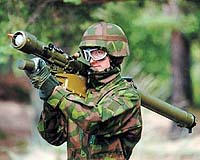 |
Washington (UPI) Dec 18, 2007 Russia's 21st century ability to out-sell the United States in a remarkably broad spectrum of conventional heavy weapons systems to countries around the world can be traced to one fundamental contrast between the U.S. and Russian economies: America invests in cutting-edge technology and leads the world in software and electronics engineers: Russia is still mired in the old supposedly -- but not really -- obsolete world of "heavy" industry -- working with machinery, steel and metal alloys. Obviously, the United States continues to show remarkable mastery of major heavy-engineering concepts in huge areas of its own weapons designs. It has, for example, 12 reliable and highly effective super-aircraft carriers operating around the world: The Russian navy is endlessly embarrassed by the miserable operational conditions of its single one, the Admiral Kuznetsov. As analyst Andrei Kislyakov recently wrote for RIA Novosti, "Launched in 1989, it has spent most of its life under repair. When an attempt was made to use it in sea trials in 2003, it started to sink. Once in 2004 and twice in 2005 landing accidents incapacitated it for long spells. And all that was accompanied by fires and multiple failures of the propulsion machinery. "The ship is a classic mess with every part of it rotten or diseased." Indeed, apart from the United States, arguably only Britain and India appear capable of operating long-range aircraft carrier task forces around the world. However, at U.S. major defense contractors, prestige and ultimately executive power primarily go to experts and executives who have mastered electronic, communications revolution, software and cybernetic disciplines. Procurement decisions in recent decades have increasingly been made by business executives, political leaders and their advisory staffs and even senior military officers who have risen by virtue of their expertise in such systems. U.S. new weapons research projects therefore have increasingly tended towards the visionary and long term, and have often been overambitious, as fiascoes like the $4 billion failure of the Future Intelligence Architecture a few years ago or the current rows over the cost-overruns on the Littoral Combat Ship indicate. Russia has had its share of those too, and the cost and scale of its boondoggle fiascoes were especially striking in the later Communist era under President Leonid Brezhnev. But the collapse of communism and the consequent loss of direct control of -- though not loss of access to -- the vast raw materials and industrial plants of the Don Basin or Donbass when Ukraine because independent at the start of 1992 forced the Russian arms industry to become lean and mean, and focus on basics in order to survive in the following decade. Those hard years paid rich dividends in the designs and underlying design philosophy that led to the weapons systems being successfully marketed around the world today. Unlike American designers, Russian weapons system designers do not look for technological shortcuts like precision-targeting or stealth technology as their main road to winning battlefield supremacy. They will certainly seek -- especially through industrial espionage -- to pirate these technologies from the United States, as the notorious Walker spy ring's success in stealing U.S. nuclear submarine communications and underwater stealth technology secrets in the 1960s and 1970s graphically proved. But in the main, Russian military systems designers look to be able to produce large numbers of weapons based on relatively simple designs that are cost-effective and robust on the battlefield. And when confronted with U.S. weapons systems that they cannot match directly like stealth bombers or nuclear-powered super-aircraft carriers, they look for asymmetrical solutions that enable them to use their own areas of expertise. Therefore, although Russia has still to demonstrate it can successfully build and operate a modern, 21st century-era large aircraft carrier, it leads the world in designing and producing relatively cheap missile systems designed to "kill" such carriers at scores, and even hundreds of miles distance. The U.S. arsenal has no weapons to compare with the SS-N-22 Moskit or the SS-N-27 Sizzler. Also, cruise missiles capable of carrying nuclear and non-nuclear warheads are a major component of both the Russian and U.S. arsenals. But Russia's cruise missiles fly two and a half times faster than U.S. ones. American cruise missiles are subsonic, but Russian-made ones can fly at well over Mach 2, or more than twice the speed of sound -- with speeds estimated at 1,500 mph to 1,700 mph at close to ground level. Also, even in the 21st century, some of Russia's most tactically important and successful arms designs, including major export items, are still based on the very different lessons in tactical combat doctrine that Russians, in contrast to Americans, drew from World War II. (Next: World War II lessons in 21st century arms design) Related Links The Military Industrial Complex at SpaceWar.com Learn about the Superpowers of the 21st Century at SpaceWar.com
 Moscow (UPI) Dec 17, 2007
Moscow (UPI) Dec 17, 2007 The Athens authorities have decided to buy 415 BMP-3 infantry fighting vehicles from Russia. (United Press International's "Outside View" commentaries are written by outside contributors who specialize in a variety of important issues. The views expressed do not necessarily reflect those of United Press International. In the interests of creating an open forum, original submissions are invited.) |
|
| The content herein, unless otherwise known to be public domain, are Copyright Space.TV Corporation. AFP and UPI Wire Stories are copyright Agence France-Presse and United Press International. ESA Portal Reports are copyright European Space Agency. All NASA sourced material is public domain. Additional copyrights may apply in whole or part to other bona fide parties. Advertising does not imply endorsement, agreement or approval of any opinions, statements or information provided by Space.TV Corp on any Web page published or hosted by Space.TV Corp. Privacy Statement |